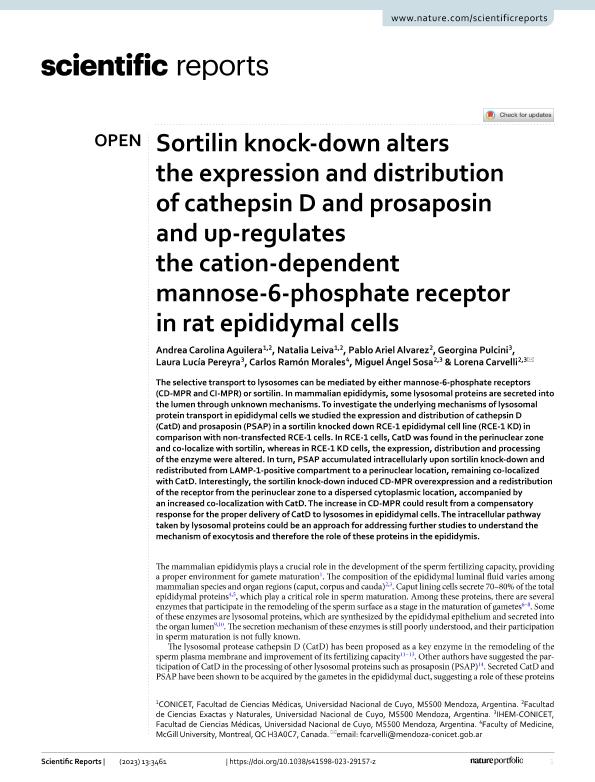Mostrar el registro sencillo del ítem
dc.contributor.author
Aguilera, Andrea Carolina

dc.contributor.author
Leiva, Natalia Lorena

dc.contributor.author
Álvarez, Pablo Ariel
dc.contributor.author
Pulcini, Georgina

dc.contributor.author
Pereyra, Laura Lucia

dc.contributor.author
Morales, Carlos Ramón
dc.contributor.author
Sosa Escudero, Miguel Angel

dc.contributor.author
Carvelli, Flavia Lorena

dc.date.available
2024-02-19T15:19:55Z
dc.date.issued
2023-02
dc.identifier.citation
Aguilera, Andrea Carolina; Leiva, Natalia Lorena; Álvarez, Pablo Ariel; Pulcini, Georgina; Pereyra, Laura Lucia; et al.; Sortilin knock-down alters the expression and distribution of cathepsin D and prosaposin and up-regulates the cation-dependent mannose-6-phosphate receptor in rat epididymal cells; Nature Research; Scientific Reports; 13; 1; 2-2023; 1-10
dc.identifier.issn
2045-2322
dc.identifier.uri
http://hdl.handle.net/11336/227486
dc.description.abstract
The selective transport to lysosomes can be mediated by either mannose-6-phosphate receptors (CD-MPR and CI-MPR) or sortilin. In mammalian epididymis, some lysosomal proteins are secreted into the lumen through unknown mechanisms. To investigate the underlying mechanisms of lysosomal protein transport in epididymal cells we studied the expression and distribution of cathepsin D (CatD) and prosaposin (PSAP) in a sortilin knocked down RCE-1 epididymal cell line (RCE-1 KD) in comparison with non-transfected RCE-1 cells. In RCE-1 cells, CatD was found in the perinuclear zone and co-localize with sortilin, whereas in RCE-1 KD cells, the expression, distribution and processing of the enzyme were altered. In turn, PSAP accumulated intracellularly upon sortilin knock-down and redistributed from LAMP-1-positive compartment to a perinuclear location, remaining co-localized with CatD. Interestingly, the sortilin knock-down induced CD-MPR overexpression and a redistribution of the receptor from the perinuclear zone to a dispersed cytoplasmic location, accompanied by an increased co-localization with CatD. The increase in CD-MPR could result from a compensatory response for the proper delivery of CatD to lysosomes in epididymal cells. The intracellular pathway taken by lysosomal proteins could be an approach for addressing further studies to understand the mechanism of exocytosis and therefore the role of these proteins in the epididymis.
dc.format
application/pdf
dc.language.iso
eng
dc.publisher
Nature Research
dc.rights
info:eu-repo/semantics/openAccess
dc.rights.uri
https://creativecommons.org/licenses/by/2.5/ar/
dc.subject
EPIDIDYMIS
dc.subject
CATHEPSIN-D
dc.subject
PROSAPOSIN
dc.subject
SORTILIN
dc.subject
CD-MPR
dc.subject.classification
Biología Reproductiva

dc.subject.classification
Ciencias Biológicas

dc.subject.classification
CIENCIAS NATURALES Y EXACTAS

dc.title
Sortilin knock-down alters the expression and distribution of cathepsin D and prosaposin and up-regulates the cation-dependent mannose-6-phosphate receptor in rat epididymal cells
dc.type
info:eu-repo/semantics/article
dc.type
info:ar-repo/semantics/artículo
dc.type
info:eu-repo/semantics/publishedVersion
dc.date.updated
2024-01-25T13:55:45Z
dc.journal.volume
13
dc.journal.number
1
dc.journal.pagination
1-10
dc.journal.pais
Reino Unido

dc.journal.ciudad
Londres
dc.description.fil
Fil: Aguilera, Andrea Carolina. Consejo Nacional de Investigaciones Científicas y Técnicas. Centro Científico Tecnológico Conicet - Mendoza; Argentina. Universidad Nacional de Cuyo. Facultad de Ciencias Médicas; Argentina. Universidad Nacional de Cuyo. Facultad de Ciencias Exactas y Naturales. Departamento de Biología; Argentina
dc.description.fil
Fil: Leiva, Natalia Lorena. Consejo Nacional de Investigaciones Científicas y Técnicas. Centro Científico Tecnológico Conicet - Mendoza; Argentina. Universidad Nacional de Cuyo. Facultad de Ciencias Médicas; Argentina. Universidad Nacional de Cuyo. Facultad de Ciencias Exactas y Naturales; Argentina
dc.description.fil
Fil: Álvarez, Pablo Ariel. Universidad Nacional de Cuyo. Facultad de Ciencias Exactas y Naturales. Departamento de Biología; Argentina
dc.description.fil
Fil: Pulcini, Georgina. Consejo Nacional de Investigaciones Científicas y Técnicas. Centro Científico Tecnológico Conicet - Mendoza. Instituto Histología y Embriología D/mend Dr.m.burgos; Argentina
dc.description.fil
Fil: Pereyra, Laura Lucia. Consejo Nacional de Investigaciones Científicas y Técnicas. Centro Científico Tecnológico Conicet - Mendoza. Instituto Histología y Embriología D/mend Dr.m.burgos; Argentina
dc.description.fil
Fil: Morales, Carlos Ramón. McGill University; Canadá
dc.description.fil
Fil: Sosa Escudero, Miguel Angel. Consejo Nacional de Investigaciones Científicas y Técnicas. Centro Científico Tecnológico Conicet - Mendoza. Instituto Histología y Embriología D/mend Dr.m.burgos; Argentina. Universidad Nacional de Cuyo. Facultad de Ciencias Exactas y Naturales; Argentina
dc.description.fil
Fil: Carvelli, Flavia Lorena. Consejo Nacional de Investigaciones Científicas y Técnicas. Centro Científico Tecnológico Conicet - Mendoza. Instituto Histología y Embriología D/mend Dr.m.burgos; Argentina. Universidad Nacional de Cuyo. Facultad de Ciencias Exactas y Naturales. Departamento de Biología; Argentina
dc.journal.title
Scientific Reports
dc.relation.alternativeid
info:eu-repo/semantics/altIdentifier/url/https://www.nature.com/articles/s41598-023-29157-z
dc.relation.alternativeid
info:eu-repo/semantics/altIdentifier/doi/http://dx.doi.org/10.1038/s41598-023-29157-z
Archivos asociados
